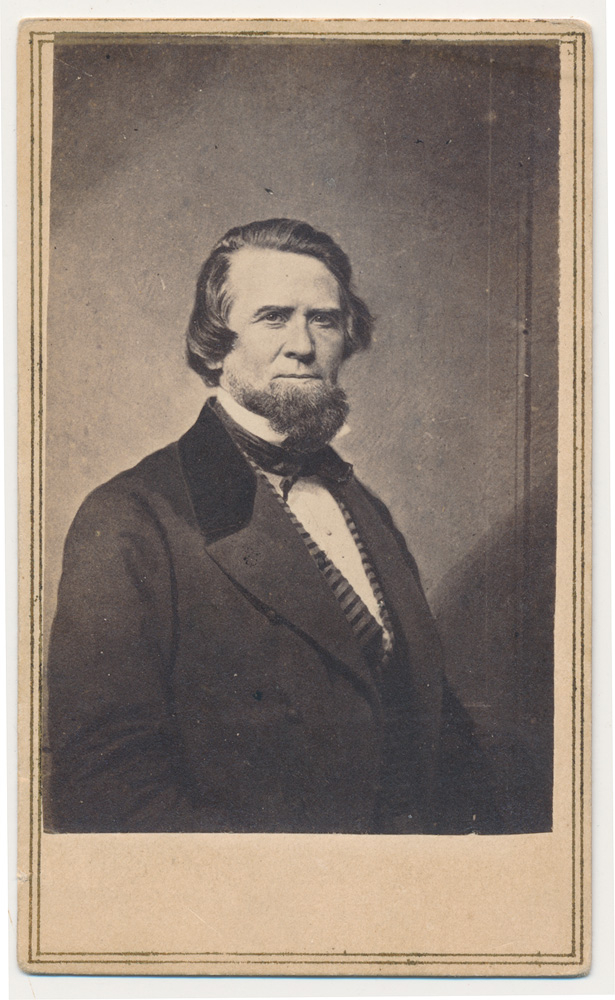site search
online catalog
WAIST-UP CDV OF GENERAL MILLEDGE L. BONHAM

Hover to zoom


$250.00
Quantity Available: 1
Item Code: 1138-48A
Shipping: Determined by Method & Location of buyer
To Order:
Call 717-334-0347,
Fax 717-334-5016, or E-mail
View is of Bonham in a dark civilian suit with a high collared white shirt and dark bowtie.
Image has good clarity and contrast. Mount and paper are very good.
Reverse has photographer’s mark for E & H. T. ANTHONY…NEW YORK. Top of reverse has old pencil ID that reads “GEN. BONHAM.”
Milledge Luke Bonham was born near Red Bank, Edgefield District, South Carolina on December 22, 1813.
Bonham, after graduation at the South Carolina College, had his first military experience as a volunteer in the company of Capt. James Jones, in the Seminole war, and was promoted to brigade major, a position corresponding to adjutant-general of brigade. Subsequently, while beginning his career as a lawyer and legislator, he continued his association with the militia and attained the rank of major-general.
When war began with Mexico he went to the front as lieutenant colonel of the Twelfth United States infantry, and served with distinction, earning promotion to colonel, and remained in Mexico a year after the close of the war, as military governor of one of the provinces.
Then returning home he resumed the practice of law, was elected solicitor of the southern circuit, and in 1856, upon the death of Preston S. Brooks, was chosen as the successor of that gentleman in Congress.
Upon the secession of the State he promptly resigned and was appointed commander-in-chief of the South Carolina army, with the rank of major-general. In this capacity, and waiving all questions of rank and precedence, at the request of Governor Pickens, he served upon the coast in hearty cooperation with General Beauregard, sent there by the provisional government of the Confederate States.
At a later date he was commissioned brigadier-general in the provisional army, and he took to Richmond the first troops, not Virginian, that arrived for the defense of the capital. His regiments were commanded by Colonels Kershaw, Williams, Cash and Bacon, and were conspicuous in the operations before Washington and in the first battle of Manassas.
Afterward, in consequence of a disagreement with the war department, he resigned and was elected to the Confederate Congress. In December, 1862, he was elected governor of the State, an of office which he filled with credit.
In January, 1865, he was appointed to command of a brigade of cavalry, in the organization of which he was engaged at the close of military operations.
His subsequent career was marked by the same ardent patriotism. As a delegate to President Grant from the taxpayers' convention, and a supporter of the revolution of 1876, he rendered the State valuable service. He was the first railroad commissioner of South Carolina, in 1878, and subsequently chairman of the commission until his death, August 27, 1890.
As a soldier he is described as "one of the finest looking officers in the entire army. His tall, graceful figure, commanding appearance, noble bearing and soldierly mien, all excited the admiration and confidence of his troops. He wore a broad-brimmed hat with a waving plume, and sat his horse with the knightly grace of Charles the Bold or Henry of Navarre. His soldiers were proud of him, and loved to do him homage. While he was a good disciplinarian, so far as the volunteer service required, he did not treat his officers with any air of superiority." [AD] [ph:L]
~~~~~~~~~~~~~~~~~~~~~~~~~~~~~~~~~~~
THIS ITEM, AS WITH ALL OTHER ITEMS AVAILABLE ON OUR WEB SITE,
MAY BE PURCHASED THROUGH OUR LAYAWAY PROGRAM.
CLICK HERE FOR OUR POLICIES AND TERMS.
THANK YOU!
Inquire About WAIST-UP CDV OF GENERAL MILLEDGE L. BONHAM
Most Popular
Historical Firearms Stolen From The National Civil War Museum In Harrisburg, Pa »
Theft From Gravesite Of Gen. John Reynolds »
Selection Of Unframed Prints By Don Troiani »
Fine Condition Brass Infantry Bugle Insignia »
Large English Bowie Knife With Sheath 1870’S – 1880’S »
Imported (Clauberg) Us Model 1860 Light Cavalry Officer's Saber »
featured item
THEFT REPORTED AT AUTUMN GETTYSBURG SHOW
A vendor at the Autumn Gettysburg Civil War show held at the Allstar Events Complex on Oct. 28-29 reported that a Maryland sword belt plate valued at $3500 was stolen from a display case on Sunday afternoon. The Gettysburg Times published a… . Learn More »


